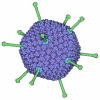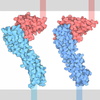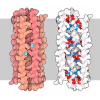[English] 日本語
 Yorodumi
Yorodumi- PDB-6opn: CD4- and 17-bound HIV-1 Env B41 SOSIP in complex with small molec... -
+ Open data
Open data
- Basic information
Basic information
| Entry | Database: PDB / ID: 6opn | |||||||||
|---|---|---|---|---|---|---|---|---|---|---|
| Title | CD4- and 17-bound HIV-1 Env B41 SOSIP in complex with small molecule GO35 | |||||||||
 Components Components |
| |||||||||
 Keywords Keywords | VIRAL PROTEIN/Immune System / HIV-1 / Env / CD4 / receptor-bound state / small molecule / fusion inhibitor / VIRAL PROTEIN / VIRAL PROTEIN-Immune System complex | |||||||||
| Function / homology |  Function and homology information Function and homology informationhelper T cell enhancement of adaptive immune response / interleukin-16 binding / interleukin-16 receptor activity / maintenance of protein location in cell / T cell selection / MHC class II protein binding / regulation of T cell activation / interleukin-15-mediated signaling pathway / cellular response to granulocyte macrophage colony-stimulating factor stimulus / positive regulation of kinase activity ...helper T cell enhancement of adaptive immune response / interleukin-16 binding / interleukin-16 receptor activity / maintenance of protein location in cell / T cell selection / MHC class II protein binding / regulation of T cell activation / interleukin-15-mediated signaling pathway / cellular response to granulocyte macrophage colony-stimulating factor stimulus / positive regulation of kinase activity / positive regulation of monocyte differentiation / Nef Mediated CD4 Down-regulation / Alpha-defensins / extracellular matrix structural constituent / T cell receptor complex / Other interleukin signaling / enzyme-linked receptor protein signaling pathway / Translocation of ZAP-70 to Immunological synapse / Phosphorylation of CD3 and TCR zeta chains / regulation of calcium ion transport / macrophage differentiation / Generation of second messenger molecules / T cell differentiation / PD-1 signaling / positive regulation of protein kinase activity / Binding and entry of HIV virion / coreceptor activity / cell surface receptor protein tyrosine kinase signaling pathway / positive regulation of plasma membrane raft polarization / positive regulation of receptor clustering / positive regulation of establishment of T cell polarity / positive regulation of interleukin-2 production / positive regulation of calcium-mediated signaling / protein tyrosine kinase binding / host cell endosome membrane / T cell activation / Vpu mediated degradation of CD4 / calcium-mediated signaling / clathrin-coated endocytic vesicle membrane / positive regulation of peptidyl-tyrosine phosphorylation / positive regulation of T cell activation / transmembrane signaling receptor activity / Cargo recognition for clathrin-mediated endocytosis / Downstream TCR signaling / MHC class II protein complex binding / Clathrin-mediated endocytosis / signaling receptor activity / virus receptor activity / clathrin-dependent endocytosis of virus by host cell / positive regulation of canonical NF-kappaB signal transduction / defense response to Gram-negative bacterium / adaptive immune response / positive regulation of MAPK cascade / positive regulation of ERK1 and ERK2 cascade / positive regulation of viral entry into host cell / early endosome / cell surface receptor signaling pathway / viral protein processing / cell adhesion / immune response / positive regulation of protein phosphorylation / membrane raft / endoplasmic reticulum lumen / external side of plasma membrane / fusion of virus membrane with host plasma membrane / virus-mediated perturbation of host defense response / fusion of virus membrane with host endosome membrane / lipid binding / viral envelope / endoplasmic reticulum membrane / virion attachment to host cell / apoptotic process / protein kinase binding / host cell plasma membrane / positive regulation of DNA-templated transcription / structural molecule activity / virion membrane / enzyme binding / signal transduction / protein homodimerization activity / zinc ion binding / identical protein binding / plasma membrane Similarity search - Function | |||||||||
| Biological species |   Human immunodeficiency virus 1 Human immunodeficiency virus 1 Homo sapiens (human) Homo sapiens (human) | |||||||||
| Method | ELECTRON MICROSCOPY / single particle reconstruction / cryo EM / Resolution: 3.5 Å | |||||||||
 Authors Authors | Ozorowski, G. / Torres, J.L. / Ward, A.B. | |||||||||
| Funding support |  United States, 2items United States, 2items
| |||||||||
 Citation Citation |  Journal: Cell Rep / Year: 2020 Journal: Cell Rep / Year: 2020Title: A Strain-Specific Inhibitor of Receptor-Bound HIV-1 Targets a Pocket near the Fusion Peptide. Authors: Gabriel Ozorowski / Jonathan L Torres / Diogo Santos-Martins / Stefano Forli / Andrew B Ward /  Abstract: Disruption of viral fusion represents a viable, albeit under-explored, target for HIV therapeutics. Here, while studying the receptor-bound envelope glycoprotein conformation by cryoelectron ...Disruption of viral fusion represents a viable, albeit under-explored, target for HIV therapeutics. Here, while studying the receptor-bound envelope glycoprotein conformation by cryoelectron microscopy (cryo-EM), we identify a pocket near the base of the trimer containing a bound detergent molecule and perform in silico drug screening by using a library of drug-like and commercially available molecules. After down-selection, we solve cryo-EM structures that validate the binding of two small molecule hits in very similar manners to the predicted binding poses, including interactions with aromatic residues within the fusion peptide. One of the molecules demonstrates low micromolar inhibition of the autologous virus by using a very rare phenylalanine in the fusion peptide and stabilizing the surrounding region. This work demonstrates that small molecules can target the fusion process, providing an additional target for anti-HIV therapeutics, and highlights the need to explore how fusion peptide sequence variations affect receptor-mediated conformational states across diverse HIV strains. #1:  Journal: Biorxiv / Year: 2020 Journal: Biorxiv / Year: 2020Title: A strain-specific inhibitor of receptor-bound HIV-1 targets a pocket near the fusion peptide and offers a template for drug design Authors: Ozorowski, G. / Torres, J.L. / Santos-Martins, D. / Forli, S. / Ward, A.B. | |||||||||
| History |
|
- Structure visualization
Structure visualization
| Movie |
 Movie viewer Movie viewer |
|---|---|
| Structure viewer | Molecule:  Molmil Molmil Jmol/JSmol Jmol/JSmol |
- Downloads & links
Downloads & links
- Download
Download
| PDBx/mmCIF format |  6opn.cif.gz 6opn.cif.gz | 372.9 KB | Display |  PDBx/mmCIF format PDBx/mmCIF format |
|---|---|---|---|---|
| PDB format |  pdb6opn.ent.gz pdb6opn.ent.gz | 303.2 KB | Display |  PDB format PDB format |
| PDBx/mmJSON format |  6opn.json.gz 6opn.json.gz | Tree view |  PDBx/mmJSON format PDBx/mmJSON format | |
| Others |  Other downloads Other downloads |
-Validation report
| Summary document |  6opn_validation.pdf.gz 6opn_validation.pdf.gz | 1.9 MB | Display |  wwPDB validaton report wwPDB validaton report |
|---|---|---|---|---|
| Full document |  6opn_full_validation.pdf.gz 6opn_full_validation.pdf.gz | 1.9 MB | Display | |
| Data in XML |  6opn_validation.xml.gz 6opn_validation.xml.gz | 65.2 KB | Display | |
| Data in CIF |  6opn_validation.cif.gz 6opn_validation.cif.gz | 94.7 KB | Display | |
| Arichive directory |  https://data.pdbj.org/pub/pdb/validation_reports/op/6opn https://data.pdbj.org/pub/pdb/validation_reports/op/6opn ftp://data.pdbj.org/pub/pdb/validation_reports/op/6opn ftp://data.pdbj.org/pub/pdb/validation_reports/op/6opn | HTTPS FTP |
-Related structure data
| Related structure data |  20150MC  6opoC  6oppC  6opqC  6x5bC  6x5cC M: map data used to model this data C: citing same article ( |
|---|---|
| Similar structure data |
- Links
Links
- Assembly
Assembly
| Deposited unit | 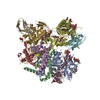
|
|---|---|
| 1 |
|
- Components
Components
-Envelope glycoprotein ... , 2 types, 6 molecules ADGBEH
| #1: Protein | Mass: 58872.902 Da / Num. of mol.: 3 Source method: isolated from a genetically manipulated source Source: (gene. exp.)   Human immunodeficiency virus 1 / Gene: env / Cell line (production host): HEK293F / Production host: Human immunodeficiency virus 1 / Gene: env / Cell line (production host): HEK293F / Production host:  Homo sapiens (human) / References: UniProt: B3UES2 Homo sapiens (human) / References: UniProt: B3UES2#2: Protein | Mass: 17357.824 Da / Num. of mol.: 3 Source method: isolated from a genetically manipulated source Source: (gene. exp.)   Human immunodeficiency virus 1 / Strain: B41 / Gene: env / Cell line (production host): HEK293F / Production host: Human immunodeficiency virus 1 / Strain: B41 / Gene: env / Cell line (production host): HEK293F / Production host:  Homo sapiens (human) / References: UniProt: B3UEZ6 Homo sapiens (human) / References: UniProt: B3UEZ6 |
|---|
-Protein / Non-polymers , 2 types, 6 molecules CFI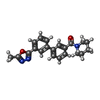

| #3: Protein | Mass: 23039.172 Da / Num. of mol.: 3 Source method: isolated from a genetically manipulated source Source: (gene. exp.)  Homo sapiens (human) / Gene: CD4 / Cell line (production host): HEK293F / Production host: Homo sapiens (human) / Gene: CD4 / Cell line (production host): HEK293F / Production host:  Homo sapiens (human) / References: UniProt: P01730 Homo sapiens (human) / References: UniProt: P01730#7: Chemical | |
|---|
-Sugars , 3 types, 33 molecules 
| #4: Polysaccharide | Source method: isolated from a genetically manipulated source #5: Polysaccharide | Source method: isolated from a genetically manipulated source #6: Sugar | ChemComp-NAG / |
|---|
-Experimental details
-Experiment
| Experiment | Method: ELECTRON MICROSCOPY |
|---|---|
| EM experiment | Aggregation state: PARTICLE / 3D reconstruction method: single particle reconstruction |
- Sample preparation
Sample preparation
| Component |
| |||||||||||||||||||||
|---|---|---|---|---|---|---|---|---|---|---|---|---|---|---|---|---|---|---|---|---|---|---|
| Molecular weight |
| |||||||||||||||||||||
| Source (natural) | Organism:   Human immunodeficiency virus 1 Human immunodeficiency virus 1 | |||||||||||||||||||||
| Source (recombinant) | Organism:  Homo sapiens (human) / Strain: HEK293F Homo sapiens (human) / Strain: HEK293F | |||||||||||||||||||||
| Buffer solution | pH: 7.4 / Details: Detergent (LMNG) added shortly (<5 minutes) prior to grid freezing using an 8X concentrated stock. | |||||||||||||||||||||
| Buffer component |
| |||||||||||||||||||||
| Specimen | Conc.: 6 mg/ml / Embedding applied: NO / Shadowing applied: NO / Staining applied: NO / Vitrification applied: YES Details: Complex of CD4- and 17b-bound B41 SOSIP was SEC purified and GO35 was diluted 1:100 into the complex and incubated for 1 hr prior to grid freezing. | |||||||||||||||||||||
| Specimen support | Grid material: COPPER / Grid mesh size: 400 divisions/in. / Grid type: C-flat-2/2 | |||||||||||||||||||||
| Vitrification | Instrument: FEI VITROBOT MARK IV / Cryogen name: ETHANE / Humidity: 100 % / Chamber temperature: 283 K |
- Electron microscopy imaging
Electron microscopy imaging
| Experimental equipment |  Model: Titan Krios / Image courtesy: FEI Company |
|---|---|
| Microscopy | Model: FEI TITAN KRIOS |
| Electron gun | Electron source:  FIELD EMISSION GUN / Accelerating voltage: 300 kV / Illumination mode: FLOOD BEAM FIELD EMISSION GUN / Accelerating voltage: 300 kV / Illumination mode: FLOOD BEAM |
| Electron lens | Mode: BRIGHT FIELD / Nominal magnification: 29000 X / Nominal defocus max: 2200 nm / Nominal defocus min: 600 nm / Cs: 2.7 mm / C2 aperture diameter: 70 µm / Alignment procedure: COMA FREE |
| Specimen holder | Cryogen: NITROGEN / Specimen holder model: FEI TITAN KRIOS AUTOGRID HOLDER |
| Image recording | Average exposure time: 12.5 sec. / Electron dose: 60 e/Å2 / Detector mode: COUNTING / Film or detector model: GATAN K2 SUMMIT (4k x 4k) / Num. of real images: 1285 |
| Image scans | Sampling size: 5 µm / Movie frames/image: 50 |
- Processing
Processing
| EM software |
| ||||||||||||||||||||||||||||||||||||||||||||||||||||||||||||
|---|---|---|---|---|---|---|---|---|---|---|---|---|---|---|---|---|---|---|---|---|---|---|---|---|---|---|---|---|---|---|---|---|---|---|---|---|---|---|---|---|---|---|---|---|---|---|---|---|---|---|---|---|---|---|---|---|---|---|---|---|---|
| CTF correction | Type: PHASE FLIPPING AND AMPLITUDE CORRECTION | ||||||||||||||||||||||||||||||||||||||||||||||||||||||||||||
| Symmetry | Point symmetry: C3 (3 fold cyclic) | ||||||||||||||||||||||||||||||||||||||||||||||||||||||||||||
| 3D reconstruction | Resolution: 3.5 Å / Resolution method: FSC 0.143 CUT-OFF / Num. of particles: 30415 Details: FSC resolution estimation calculated using CryoSparc 2 and Relion 3.0 Num. of class averages: 1 / Symmetry type: POINT | ||||||||||||||||||||||||||||||||||||||||||||||||||||||||||||
| Atomic model building | Protocol: FLEXIBLE FIT / Space: REAL | ||||||||||||||||||||||||||||||||||||||||||||||||||||||||||||
| Atomic model building | PDB-ID: 5VN3 |
 Movie
Movie Controller
Controller







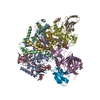
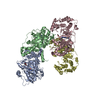
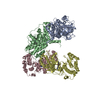
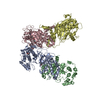
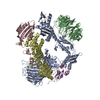
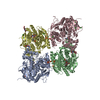
 PDBj
PDBj










